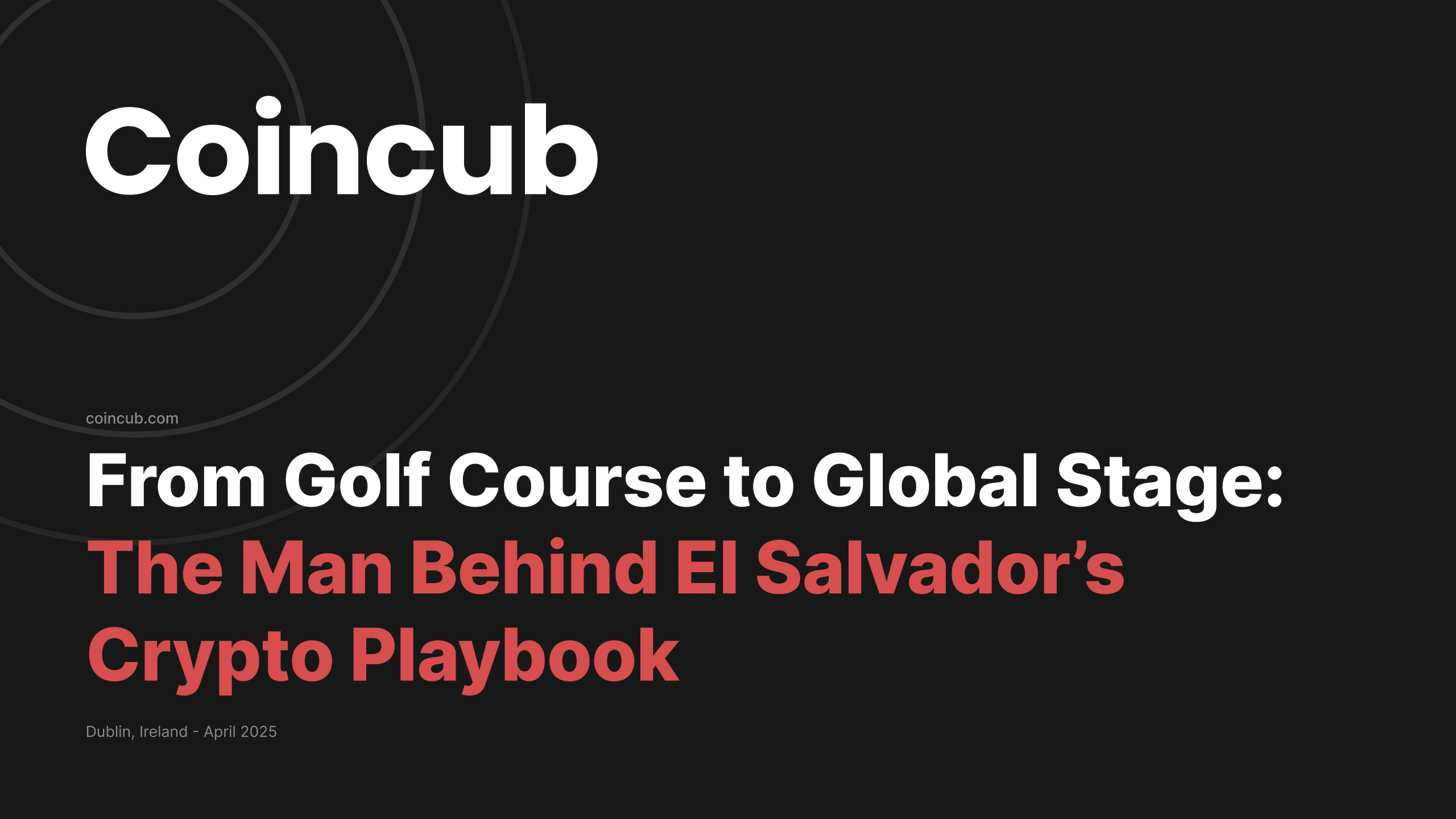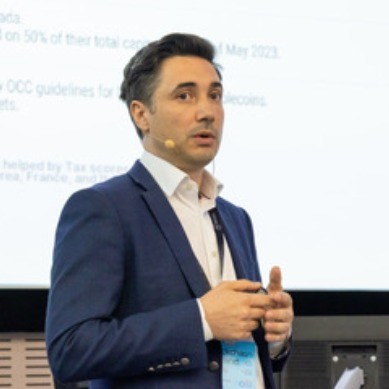From Golf Course to Global Stage: The Man Behind El Salvador’s Crypto Playbook

It’s 5:30 AM in El Salvador, and the sun is just beginning to rise over a pristine golf course’s lush, rolling greens. A gentle breeze carries the scent of freshly cut grass as a golf cart comes along the path. This is where I find Juan Carlos Reyes, the President of El Salvador’s National Commission of Digital Assets (CNAD). Golf, he tells me, is his religion – a daily ritual that clears his mind and sharpens his focus. As we talk, he shares images of the course: the perfect weather, a blue sky unmarred by clouds, and the serene calm of the early morning. It’s an apt metaphor for Reyes’ approach to regulation – methodical, clear-sighted, and driven by precision.
The Architect of El Salvador’s Digital Asset Future
Juan Carlos Reyes is leading one of the most ambitious financial experiments in modern history: El Salvador’s adoption of Bitcoin and Cryptocurrencies as a cornerstone of its economic strategy. As the President of the National Commission of Digital Assets (CNAD), Reyes has played a crucial role in shaping the country’s Digital Assets framework, ensuring that the integration of digital assets is not only innovative but also legally structured for long-term success.
Reyes’ approach to digital asset regulation is both pragmatic and forward-thinking. In his recent article, “El Salvador’s Blueprint for Digital Asset Regulation,” he outlines the country’s strategy for building a legal foundation that fosters investment, financial inclusion, and compliance. El Salvador has embraced a regulatory-first approach, unlike other regions that struggle to integrate digital assets within outdated frameworks – yes, looking at you, Europe. In contrast, El Salvador offers clear guidelines while maintaining a pro-business stance. This balance has attracted international attention, positioning the country as a case study for digital asset adoption.
However, Reyes is not just focused on policy; he is also deeply involved in addressing the challenges associated with financial innovation. He’s highlighting the importance of collaboration with global players like Tether, which recently announced its physical headquarters in El Salvador.
Could El Salvador’s Approach Serve as a Global Blueprint?
Beyond regulation and security, Reyes believes that El Salvador’s model could serve as a blueprint for other developing nations. In “The Engineless Car: Why Developing Nations Could Lead the Digital Asset Revolution,” he argues that emerging economies have a unique advantage – legacy financial systems do not burden them. Instead, they can leapfrog traditional banking structures by adopting decentralized finance (DeFi) and digital assets, allowing for greater financial inclusion and economic growth. They’ve done it with Bitcoin implementation nationwide, which has worked even during the most recent bear market and political turbulences. El Salvador is not just experimenting with Bitcoin – it is building a robust, scalable digital asset ecosystem that challenges the status quo of global finance. They are redefining how nations approach digital assets, focusing on regulations while leaving space for progress to create a sustainable model for the future.
Everyone opposed it, even international financial agencies like the IMF, which warned and even threatened El Salvador. However, this did not stop them from pursuing their plan.
The Vision for CNAD and Digital Assets
Reyes’ leadership at CNAD has been pivotal in shaping El Salvador’s digital asset landscape. Since its inception, CNAD has worked to create a regulatory framework that balances rapid growth with consumer protection, similar to that of all other agencies worldwide.
“El Salvador has cracked the code. Our approach ensures that digital assets drive real economic growth and support El Salvadorians.”
Under his guidance, CNAD has implemented strict measures to vet digital asset service providers (DASPs).
“We’ve built a system that starts with rigorous pre-registration processes… From Know Your Customer (KYC) to Know Your Business (KYB) checks, we ensure that only legitimate players enter our market.”
This diligent approach has made El Salvador a haven for responsible tokenization and smart contract governance.
A Global Perspective on Regulation
Reyes quickly emphasizes that El Salvador’s success isn’t just a local achievement – it’s a global precedent.
“We’ve offered our help to other nations, including Argentina and Colombia,” he says. “Our goal is to create a cohesive regulatory framework across Latin America.” He envisions a future where Latin America leads the world in crypto adoption, turning potential into prosperity.
When asked about the global crypto economy, Reyes says, “The cryptocurrency market is already worth over $3 trillion, and tokenized real-world assets could hit $10-30 trillion by 2030. We act accordingly.”
Libra Coin: Where Did Argentina Go Wrong?
The conversation turns to recent failures in the crypto space, like Argentina’s Libra coin debacle. Reyes sees these incidents as cautionary tales.
“What happened with Libra could never happen in El Salvador. Our laws require every digital asset to pass through CNAD’s approval process before it can be marketed or sold.”
He highlights how El Salvador’s independent risk assessment filters out high-risk or speculative projects, ensuring consumer safety. We believe this is the only way to undergo a safe, efficient mass onboarding in the industry.
Reyes also touches on the broader implications of these failures: “They underscore the need for robust legislation. A simple registry isn’t enough; you need comprehensive laws that address every aspect of digital assets.”
The FATF Deal and the Birth of a Regional Power Play
One chapter in El Salvador’s digital asset journey has been its evolving relationship with the Financial Action Task Force (FATF). Mr. Reyes has positioned El Salvador as a compliant player. “Our goal is to go beyond FATF’s principles and to build something better – something tailored for digital assets,” Reyes asserts.
The stakes are high. The FATF’s skepticism toward El Salvador’s adoption of Bitcoin has been well-documented. Threats of grey-listing loom nationwide due to perceived gaps in the country’s anti-money laundering (AML) framework. Yet, Reyes sees this as an opportunity rather than a setback.
“The FATF framework was built for traditional finance. Digital assets fundamentally differ – they require new tools, thinking, and laws.”
At the upcoming DAS SV conference, Reyes aims to showcase how El Salvador’s digital asset law and risk matrix have created a safer and more transparent environment than many FATF-compliant nations. The conference will also include workshops on how countries can avoid the pitfalls seen in Argentina’s Libra coin collapse and other regulatory failures.
“We’re not just talking about compliance and regulation. We’re talking about leadership – about setting a global standard for digital asset regulation.”
DAS.SV: A New Chapter for Digital Assets in El Salvador
Digital Asset Summit – El Salvador is a call to action for regulators, set against El Salvador’s reputation as a regional leader in digital asset regulation. Juan Carlos describes it as “a platform to demystify risk and showcase hands-on tools, methods, and regulation approaches that can help regulators steer from stage zero.”
On April 29, 2025, DAS.SV will convene regulators, policymakers, and industry leaders from over 25 countries to share insights and develop frameworks that can serve as blueprints for responsible progress.
“Our goal with DAS.SV is to empower nations that are at ground zero when it comes to digital asset regulation.”
The event will feature workshops on risk assessment, compliance frameworks, and case studies highlighting El Salvador’s successes. Panels on tokenized real-world assets will be followed by discussions on combating crypto crime and DAS.SV promises to be a masterclass in regulating accordingly. Reyes envisions this conference as the first step toward creating a unified regulatory body for Latin America – a vision that could reshape the global digital economy.
Crypto Crime Is on the Rise – But It Doesn’t Exist
People often assume that technology is to blame when they hear about a crime involving cryptocurrency. Some even think of crime whenever they hear about crypto – imagine. But Juan Carlos Reyes has another opinion.
“Of course, there is crime within crypto, but I’m trying to say there’s nothing new under the sun. The criminals do the same thing as they always do. They’re just using crypto as a tool.”
In other words, the bad guys haven’t changed—just their methods. He believes Nick Furnaeux is correct – there is no crypto crime, only crime itself.
At various conferences, Reyes has emphasized that crime isn’t unique to crypto. Whether it’s fraud, money laundering, or theft, these crimes existed long before Bitcoin. The difference? Unlike cash, crypto transactions are permanently recorded on a public blockchain. If anything, this makes them easier to track.
“If criminals were to use blockchain crypto to commit crimes, we wouldn’t really have unsolved cases because the evidence would be traceable.”
Compare that to traditional finance, where criminals can move illicit funds through shell companies, offshore accounts, and cash smuggling with little trace. With blockchain, every transaction is logged, meaning authorities have a clear trail to follow. So, while Hollywood loves the image of anonymous hackers in hoodies laundering millions in Bitcoin, the reality is that criminals prefer cash.
Regulations Are the Issue, Not Crypto
So, is crypto a haven for criminals? Not really. Using Bitcoin for crime is like robbing a bank, leaving your ID at the scene, live-streaming it to the entire world, and then permanently recording that live stream on a public ledger.
Criminals consider crypto to be another tool to use. You don’t blame a slim jim (the most common car theft tool) for car theft, do you? One major challenge is that many jurisdictions still lack proper oversight. In some countries, compliance standards for crypto are either weak or nonexistent, allowing bad actors to operate with little resistance. Without strict KYC and KYB procedures, authorities struggle to track where funds come from or where they go. This gap in compliance has made some regions hotspots for money laundering and fraud.
“Most legal systems take forever. It’s very frustrating, as they’re usually slow and don’t have the right tools adapted for the digital asset space,” he admits, emphasizing the need for regulatory agility. El Salvador has introduced a task force that includes Supreme Court judges to address this. This group ensures that regulatory actions, such as asset freezes, can swiftly executed when the necessary information is provided.
Looking ahead, Reyes believes global regulators must integrate expertise from traditional finance and digital assets rather than treating crypto as an isolated phenomenon. “We need expertise from both sides,” he asserts, drawing parallels between the evolution of traditional and digital finance. As regulatory frameworks mature, countries that adapt quickly and efficiently will likely lead the way in defining the global standard for digital asset oversight.
A New Way For Regulators
As our conversation winds down, I asked Reyes what advice he would give to regulators worldwide.
“Understand the technology before you regulate it. And most importantly, don’t stifle innovation – embrace it. Regulation isn’t about control but creating opportunities while protecting people. If we get this right, we can transform not just economies but the lives of El Salvadorians and beyond.”
The future of digital asset regulation is set to become more structured and proactive, moving beyond reactive enforcement to comprehensive frameworks that facilitate compliance while promoting growth. Juan Carlos Reyes highlights the importance of efficient legal mechanisms, noting that bureaucratic inefficiencies remain challenging while regulation advances.
Before he heads off to his next hole on the golf course, I pose one final question: What message would you send to regulators hesitant about embracing digital assets? He leans back in his seat, gazing at the horizon. “The world is changing,” he says thoughtfully. “You can either lead that change or be left behind.”




